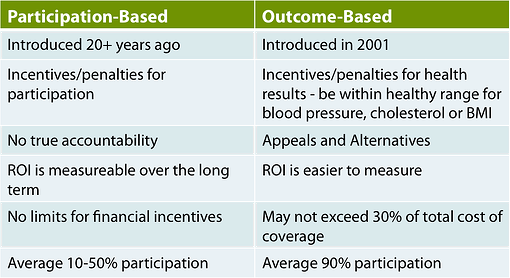Many employers are turning to financial incentives as a way to increase participation in worksite wellness programs. The new regulations under the Affordable Care Act increases wellness incentives - from 20% to 30% of the cost of health coverage - and this change is causing many employers to transition to outcomes-based wellness programs. But are outcome-based incentives right for your wellness program? Let's put them head-to-head to list the pros and cons of each.
To start, here is a quick summary of these two incentive options:

Participation-Based
PROS: Simple activities and rewards are a good way to introduce employees to wellness. These incentives are typically perceived as being fair and attainable by employees because they can be achieved by all - including those whose health status is less than optimal. Generally, there are very few legal restrictions on participation only programs.
CONS: Telling employees about their risks and providing education won't necessarily lead them to take action. These incentives may not result in long-term behavior change. Determining the ROI can be difficult and it can take years see results.
Outcomes-Based
PROS: Outcomes-based programs are a more aggressive approach to wellness. Healthy employees are rewarded for being and staying healthy. Research shows that this model is effective at making people improve their health. It can also help accelerate a healthy cultural shift within the organization.
CONS: This model could be discriminatory and decrease access to health care. Legally, employers must offer staff that don't hit targets an alternative way to earn the incentive, such as a doctor's note or program participation, so some experts believe these laws turn an outcomes-based program into a participation-based program. There has also been growing backlash from employees, so employers need to implement this strategy cautiously.
While these are the most popular kinds of corporate wellness incentives there a variety of other options - and many employers try a combination of incentives to support their wellness programs.
At TotalWellness, we support clients in implementing both participation and outcomes-based health incentives. To maximize engagement and minimize employee dissatisfaction, we recommend starting out with a participation-based incentive design for the first two-three years and then moving to an outcomes-based incentive.



